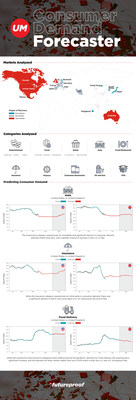Machine Learning Model Uses Advanced Analytics to Forecast Consumer Behavior across 10 Categories and 15 Countries
First Report on Automotive, Insurance and Food Delivery Suggests Greater Rebound in U.S. vs U.K. across Adversely Impacted Categories
NEW YORK – May 7, 2020 – UM, the global marketing and media agency network of IPG Mediabrands, today released the Consumer Demand Forecaster, its proprietary machine learning model that predicts the rise and fall of consumer demand in various markets amidst the COVID-19 crisis. The accompanying series of reports provides a roadmap for brand marketing re-entry strategies across 10 major categories, including Automotive, Consumer Electronics, CPG, Entertainment, Finance, Food, Insurance, Oil & Gas, Retail and Travel.

The first set of findings predicts consumer trends across highly impacted categories including Automotive, Insurance (automotive, motorcycle, home, life, travel and cyber) and Food Delivery for the U.S. and U.K. markets. In the Automotive and Insurance categories, there are consistent signs that consumer demand in the U.S. will rebound in mid-May and approach pre-COVID-19 levels by early June. In the U.K., however, there are little to no signs of recovery in consumer demand over the same period.
Using online search data as a representation of consumer demand, the Consumer Demand Forecaster leverages advanced analytics to predict the timing, rate and extent of recovery in consumer demand across 15 countries in different stages of the COVID-19 crisis, enabling marketers to plan their re-entry appropriately. Additional insights across categories will be released weekly.
“Our data-fueled model provides practical, actionable media guidance to help brands respond to and prepare for recovery from the COVID-19 pandemic,” said Huw Griffiths, Global Chief Product Officer, UM. “By predicting the rise and fall of consumer demand across categories, and the magnitude and shape of that demand, we are able to advise brands on when and how to re-enter the market in both the short- and long-term, with the goal of future-proofing their businesses during this uncertain time.”
The model tracks a variety of key factors that influence consumer behavior in each category, including: new, confirmed and recovered COVID-19 cases; days since 100 confirmed COVID-19 cases; the consumer confidence index (CCI); the number of government restrictions; household size; disposable income; unemployment; seasonality and more.
Read Full Article Here.



